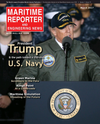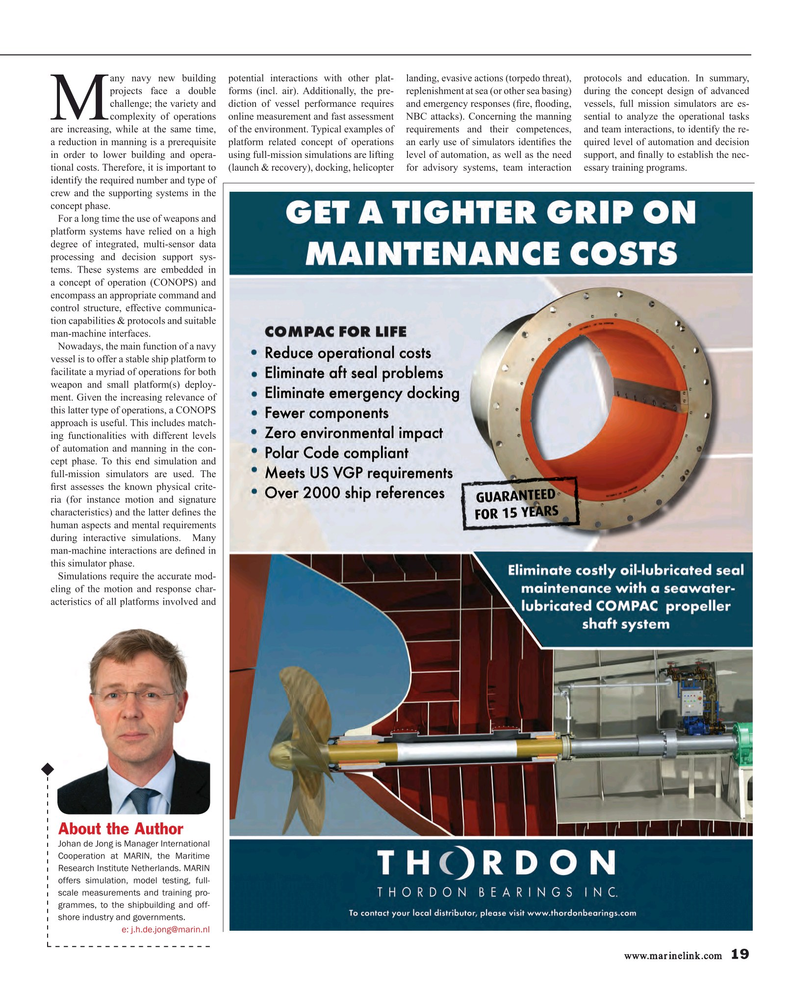
Page 19: of Maritime Reporter Magazine (March 2017)
U.S. Navy Quarterly & Maritime Simulation Technologies
Read this page in Pdf, Flash or Html5 edition of March 2017 Maritime Reporter Magazine
any navy new building potential interactions with other plat- landing, evasive actions (torpedo threat), protocols and education. In summary, projects face a double forms (incl. air). Additionally, the pre- replenishment at sea (or other sea basing) during the concept design of advanced challenge; the variety and diction of vessel performance requires and emergency responses (? re, ? ooding, vessels, full mission simulators are es-
Mcomplexity of operations online measurement and fast assessment NBC attacks). Concerning the manning sential to analyze the operational tasks are increasing, while at the same time, of the environment. Typical examples of requirements and their competences, and team interactions, to identify the re- a reduction in manning is a prerequisite platform related concept of operations an early use of simulators identi? es the quired level of automation and decision in order to lower building and opera- using full-mission simulations are lifting level of automation, as well as the need support, and ? nally to establish the nec- tional costs. Therefore, it is important to (launch & recovery), docking, helicopter for advisory systems, team interaction essary training programs. identify the required number and type of crew and the supporting systems in the concept phase.
For a long time the use of weapons and platform systems have relied on a high degree of integrated, multi-sensor data processing and decision support sys- tems. These systems are embedded in a concept of operation (CONOPS) and encompass an appropriate command and control structure, effective communica- tion capabilities & protocols and suitable man-machine interfaces.
Nowadays, the main function of a navy vessel is to offer a stable ship platform to facilitate a myriad of operations for both weapon and small platform(s) deploy- ment. Given the increasing relevance of this latter type of operations, a CONOPS approach is useful. This includes match- ing functionalities with different levels of automation and manning in the con- cept phase. To this end simulation and full-mission simulators are used. The ? rst assesses the known physical crite- ria (for instance motion and signature characteristics) and the latter de? nes the human aspects and mental requirements during interactive simulations. Many man-machine interactions are de? ned in this simulator phase.
Simulations require the accurate mod- eling of the motion and response char- acteristics of all platforms involved and
About the Author
Johan de Jong is Manager International
Cooperation at MARIN, the Maritime
Research Institute Netherlands. MARIN offers simulation, model testing, full- scale measurements and training pro- grammes, to the shipbuilding and off- shore industry and governments. e: [email protected] www.marinelink.com 19
MR #3 (18-25).indd 19 MR #3 (18-25).indd 19 3/6/2017 5:29:05 PM3/6/2017 5:29:05 PM

 18
18

 20
20
